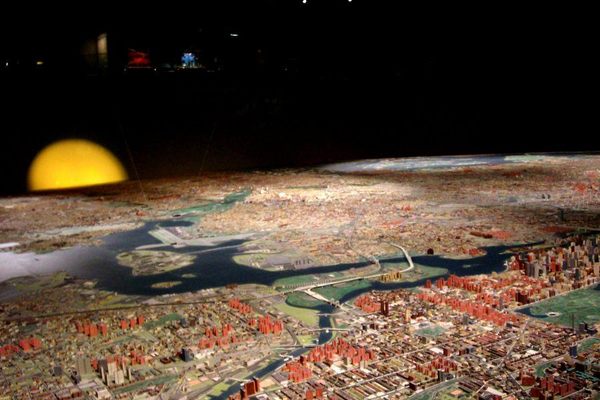Relics of the World’s Fair: Brussels
The 1958 World’s Fair 1958 (photograph by Charles Roberts)
After visiting Paris, Chicago, Barcelona, New York City, Montreal, St. Louis, Melbourne, and Seattle, Atlas Obscura’s next stop in our tour of World’s Fair relics is Brussels, host to four World’s Fairs. As with most other cities, only a handful of relics survive — but one of them still turns heads today.
Brussels’ first fair in 1897 — the Brussels International, or Exposition Internationale de Bruxelles — left a definite impact on art history, as the fair planners used an Art Nouveau style for all the fair’s architecture and advertising, helping to promote the then-new art movement. The one building from 1897 still standing is the intriguingly-named Temple of Human Passions. The Temple is actually a pavilion meant to show off ”Human Passions,” a huge marble relief mural depicting various human obsessions, with unsavory acts such as war and rape among more startling pursuits.
Detail of “Human Passions,” Jef Lambeaux, detail (photograph by Travis Nelson)
Architect Victor Horta was commissioned to design the Temple in the more traditional neoclassic style, but Horta had already begun exploring the Art Nouveau movement, and experimented with some subtle Art Nouveau details for its design. Minor as they were, the relief sculptor Jef Lambeaux objected to the design. In particular, he wanted a wall between his relief and the Temple’s entrance. Horta fought back, insisting on an open design with part of the relief visible from the outside. The conflict between them went on so long that the Temple was still unfinished by the start of the fair. However, critics weren’t fond of Lambeaux’s work anyway; one was especially harsh on the tableaux:
“…a pile of naked and contorted bodies, muscled wrestlers in delirium, an absolute and incomparable childish concept. It is at once chaotic and vague, bloated and pretentious, pompous and empty.”
Fair organizers dealt with the mess by building a barricade around the Temple to keep out fairgoers. Then Brussels left up the barricade. After Lambeaux’s death in 1908, Horta — who went on to world renown as a master of Art Nouveau architectural design — finally built the wall, but the Temple stayed closed to the general public until 2002. Today, the Temple is only open for one hour a day, every day, except Mondays.
Temple of Human Passions (photograph by William Murphy)
A landmark from Brussels’ most recent fair in 1958 — Expo 58 — is equally eye-catching, but in a much more modern way. Designed to resemble a single cell from an iron crystal, the Atomium consists of nine 59-foot stainless steel spheres, connected by a series of hollow tubes.
photograph by O Palsson
The inside of the spheres are hollow, and offered exhibition space during the fair; the tubes are also hollow, to allow guests to travel from one sphere to the next.
Atomium stairs (photograph by Harald Hoyer)
In 2004, the city of Brussels began extensive renovations on the building. Wind tunnel tests proved that the original design was actually unsafe — the structure rested entirely on the bottommost spheres, and engineers proved that the whole building could have toppled over in a high enough wind. Renovations included support columns meant to anchor the building in place, and today only five of the spheres are open to the public.
View from Atomium (photograph by Björn Láczay)
The top sphere today serves as a viewing platform, offering guests a panoramic view of Brussels, while lower-level spheres are home to a series of exhibits about the 1958 fair itself.
Inside the Atomium (photograph by Jerry Pank)
The Atomium in 1958 (photograph by Charles Roberts)
Here are some more photographs from the World’s Fair in Brussels:
The Venezuela Pavilion at Expo 58 (photograph by Wouter Hagens)
Part of a ship in the Dutch pavilion at Expo 58 (photograph by Wouter Hagens)
USSR Pavilion at Expo 58 (photograph by Wouter Hagens)
United States Pavilion at Expo 58 (photograph by Wouter Hagens)
Yugoslavia pavilion at Expo 58 (via Wikimedia)
The UK Pavilion (photograph by Wouter Hagens)
Expo 1958 Brazil pavilion (photograph by Wouter Hagens)
Expo 1958 Belgium scale model (photograph by Wouter Hagens)
Expo 1958 Philips Pavilion (photograph by Wouter Hagens)
Expo 58 (photograph by Charles Roberts)
United States Pavilion at Expo 58 (photograph by Charles Roberts)
Expo 58 (photograph by Charles Roberts)
Expo 58 (photograph by Charles Roberts)
Expo 58 (photograph by Charles Roberts)
Expo 58 (photograph by Charles Roberts)
Expo 58 (photograph by Charles Roberts)
Stay tuned for more in our series on World’s Fair relics, and be sure to visit Paris, Chicago, Barcelona, New York City, Montreal, St. Louis, Melbourne, and Seattle.









Follow us on Twitter to get the latest on the world's hidden wonders.
Like us on Facebook to get the latest on the world's hidden wonders.
Follow us on Twitter Like us on Facebook